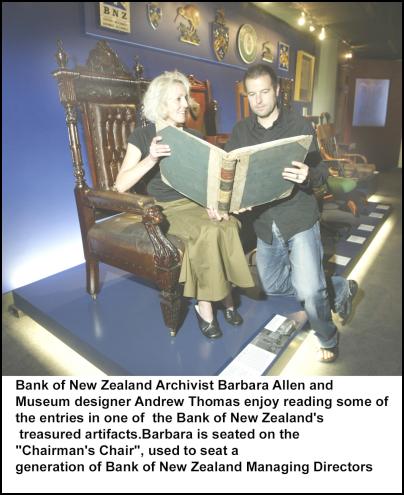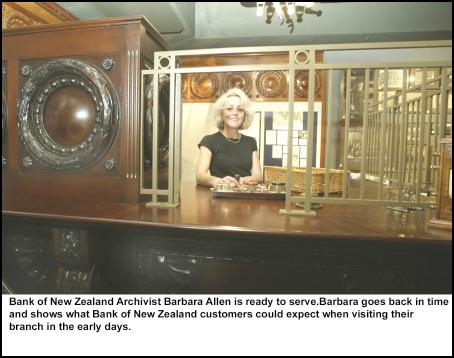New Museum Brings To Life 140 Years Of Business
New Museum Brings To Life 140 Years Of Business And Finance In New Zealand
Feature article supplied by Bank of New Zealand
By Zaman Toleafoa

It's 1861, and like many other early New Zealand settlers, the glitter of gold entices an enterprising young man, Falconer Larkworthy, to the goldfields of Otago. Except Larkworthy isn't there to search for gold - Larkworthy lets the miners bring the gold to him.
Larkworthy arrived at Waitahuna, inland from Dunedin, in October 1861. His aim; to secure Bank of New Zealand's foothold (which earlier that year had been established in Auckland) in New Zealand. But Larkworthy encounters a problem - a shipment of Bank of New Zealand banknotes arriving from England has been delayed. Undeterred, Larkworthy sets up camp, prints and signs an issue of 20,000 pounds in official bank notes and exchanges them with goldminers for gold. In that enterprising act, Larkworthy secures Bank of New Zealand's important place in New Zealand's financial and economic future.
Despite their immediate interest in the Otago goldfields, the backers of Bank of New Zealand, who were also Larkworthy's employers, recognised that there was a much bigger game afoot.
The goldfields provided a market in which the backers of the bank - most of whom were businessmen, the majority from Auckland - could quickly grow their captial base. But the bank's backers recognised the massive potential that lay in the colony of New Zealand. Frozen meat exports to England were on the horizon and wool farming was spreading out across the country. The colonial and provincial governments were preparing to spend widely on a railway network to serve the fast-growing towns around the coast.
The young colony was hungry for finance - and banks - to fund these ventures. The founders of Bank of New Zealand were eager to be one such bank.
Some dark years would follow quickly - including in the 1880s when the country survived its first economic downturn - but eventually Bank of New Zealand would emerge as a major institution central to business and finance in New Zealand.
The story of Larkworthy's expedition to the goldfields is one of the stories told in the newly-opened Bank of New Zealand museum in Wellington.
Bank of New Zealand has opened the museum to showcase the role of banking in New Zealand and the part that Bank of New Zealand has played in New Zealand business for more than 140 years.
The museum has been more than a year in the making. Initially, it is open to Bank of New Zealand staff and customers; from mid-2004 it will be open to school groups and other people who are interested.

The museum includes items from the goldfields days, including some early bank notes and gold-buying equipment. From more recent history, the museum includes exhibits on automation and computerisation in banking, a field in which Bank of New Zealand led the way.
The museum also includes features on the KZ7 America's Cup yachting challenge in 1986-87, a display of furniture used by the bank over 100 years, and a fascinating display of marketing material and advertising (meet… ;the BNZ girl' of the 1970s) that reveals the degree of social change in New Zealand in the last 50 years. Top New Zealand museum designer Andrew Thomas led the team that developed the displays.
Bank of New Zealand managing director, Peter Thodey, says the museum captures the optimism and entrepreneurship of early New Zealanders, but also reflects the changing face of New Zealand over the past 140 years.
"Bank of New Zealand has always been alongside New Zealand businesses and communities, right from the kick-off on the goldfields. The museum brings to life that story over 140 years," Peter Thodey says.
So, remember this? The days before ATMs. Bank of New Zealand installed its first ATMs - 60 of them - in 1983. Customers could use the new machines - known then as Autobanks - between 7.00 am and 11.00 pm. Today there are more than 300 ATMs in the Bank of New Zealand network and they operate 24 hours a day.
What about this? The days when all inter-bank transfers were done manually - that means cheque clearances and automatic payments, handled one-by-one. It seems extraordinary, but it was less than 40 years ago.
In the mid-1960s Bank of New Zealand recognised that computerisation was the answer to such laborious and expensive processes. In 1966 the Bank successfully undertook the daunting task of processing cheque and deposit transactions electronically, and achieved the overnight settlement of inter-bank transactions, a world first.
And can you remember the days when you had to have cash to buy anything? Well, EFTPOS - which is part of our lives today - was launched by Bank of New Zealand less than 20 years ago, in 1985. At the time, some people predicted EFTPOS wouldn't last. Today, New Zealanders are among the highest users of EFTPOS in the world.
Helen Grant, who has managed the establishment of the museum for Bank of New Zealand, says: "One of the stories that comes out in the museum is the speed of change in forms of currency substitutes.
"Not so long ago, cash was the predominant form of currency in New Zealand. Basically, to buy something you had to have some folding stuff. However, banks have made it easier and easier to buy things without having to have cash. Purchasing today is highly convenient thanks to EFTPOS, credit cards, and automated payments."
The museum also features one of Bank of New Zealand's most inspiring periods: that was when the bank decided to back KZ7, the New Zealand yacht that had no more than an outside chance of challenging the Australians for the America's Cup in Perth in the summer of 1986-87.
In the end, KZ7 - also known as the Plastic Fantastic - did better than anyone expected. A small country was left inspired by what it could do up against the world's yachting giants.
The museum includes a gold pressing of the single ‘Sailing Away', which was written for the yachting campaign. More than 17 years later, the song remains one of New Zealand's biggest selling local singles and for thousands of New Zealanders the notes of the song instantly remind them of the extraordinary summer they spent watching the little boat that could.
ENDS


 School Lunch Collective: Compass Group New Zealand To Acquire Libelle Group Securing Healthy School Lunch Programme
School Lunch Collective: Compass Group New Zealand To Acquire Libelle Group Securing Healthy School Lunch Programme PSA: PPPs Pose Risks To New Zealand Workers
PSA: PPPs Pose Risks To New Zealand Workers Office of the Privacy Commissioner: New Research Shows Business Leaders Fear Being On The Hook For Others’ Privacy Breaches
Office of the Privacy Commissioner: New Research Shows Business Leaders Fear Being On The Hook For Others’ Privacy Breaches E Tū: E Tū Members Send Open Letter To James Grenon And NZME Board
E Tū: E Tū Members Send Open Letter To James Grenon And NZME Board Commerce Commission: Commission Calls For Comments On Copper Access Deregulation
Commerce Commission: Commission Calls For Comments On Copper Access Deregulation New Zealand Association of Scientists: NZAS Supports Saving Biotechnology Capacity In Callaghan; Asks What Now For Applied Technology Group
New Zealand Association of Scientists: NZAS Supports Saving Biotechnology Capacity In Callaghan; Asks What Now For Applied Technology Group



